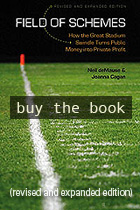This is an archived version of a Field of Schemes article. Comments on this page are closed. To find the current version of the article with updated comments, click here.
July 02, 2004
Reports: Nets, Jets plans not so hot
Man, go away for a couple of days to visit a volcano, and all hell breaks loose. (Okay, not that kind of hell.) Two new studies are out this week questioning the claims of the New Jersey Nets and New York Jets on the economic impact of new publicly subsidied sports facilities; both say they're not all they're cracked up to be, though to widely varying degrees.
On Monday, the Brooklyn community group Develop Don't Destroy released an extensive critique (PDF file here) by Jung Kim and Gustav Peebles of developer Bruce Ratner's Nets arena economic impact study, charging that author Andrew Zimbalist had overestimated the incomes of both tenants and workers in the project, underestimated the degree by which Brooklyn office space vacancies are largely filled by government agencies, underestimated the value of the Long Island Rail Road yards where the arena would be built, and failed to account for the cost of educating the estimated 931 public school students who would live in the complex. The upshot: Zimbalist's $800 million profit for the city would turn into a loss of between $100 million and $500 million.
(Zimbalist, who hadn't yet read the report, told the Daily News: "I don't think any of the data I used is incorrect, so I obviously disagree with that point.")
On Thursday, the New York City Independent Budget Office followed with its own report on the proposed $1.4 billion Jets stadium on Manhattan's West Side, which would get $600 million in public subsidies. (This is different, by the way, from the promised IBO study on the broader $5 billion Hudson Yards plan, which is still in the works.) The Jets had estimated $35.1 million a year in new city tax revenues, and 6,971 jobs created; IBO countered that their figures showed $28.4 million a year in fiscal impact and 3,586 jobs created.
While this would still be enough to pay the city's $21 million a year in bond payments on its share of the stadium, it's worth noting that the IBO did accept at face value some assumptions that other economic experts have questioned: for example, that the facility would draw two sports "mega-events" and numerous expositions (the Jets say 35; IBO assumes 20) each year. Without such events, football games alone at the facility would amount to only $9.2 million a year in city tax revenue, according to the IBO - making for a nearly $12 million a year loss for the city treasury.
In related news, Metropolitan Transportation Authority chair Peter Kalikow has now agreed to hire outside appraisers to determine the value of the railyards where the Jets and Nets facilities would be built. Both teams have agreed to pay "fair market" value, but estimates of those values have varied widely. If the land appraisals go up, it's unclear whether the teams or taxpayers would pay the additional costs; if the latter, all the economists will have to go back and recrunch all their numbers.





